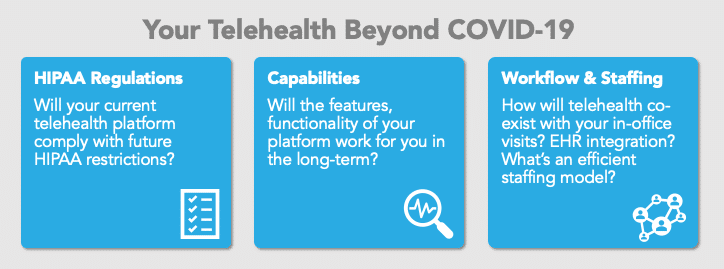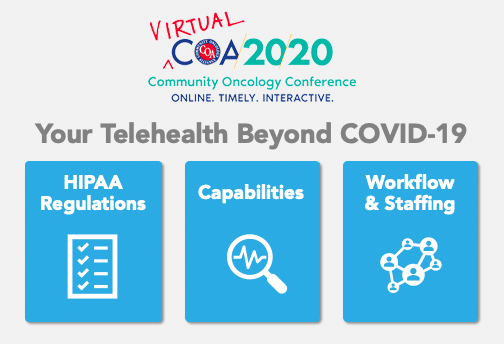Telehealth has swiftly taken hold as important tool to safely deliver cancer care during the COVID-19 crisis and many see it as a permanent part of care moving forward. Nick Recker, the President of Path Forward, recently presented what he sees emerging in telehealth and information technology for cancer programs at COA’s virtual conference.
As recently as January the road to telehealth looked challenging, but today he noted most obstacles are gone. There are still barriers – interoperability guidance, safety, reimbursement, and HIPAA compliance, but we’ve seen much of the red tape stripped away and a quick adoption of these telemedicine services.
Emergence of Telehealth Tools
He advised to think of telehealth as a tool, not a replacement for in person visits. He also recommended that practices start planning for the long term now and even suggested assembling a committee who can own the telehealth service for your practice. You’ll need to determine things like:
- Requirements of how you’re going to use it
- What type of visits will qualify
- How you can reduce inefficiencies that can result from quick implementation of technology
He also recommended surveying patients to create a baseline about what they like, what they don’t like and what’s been challenging.
It’s also important to think about best practices for configuration. Nick pointed out that many medical practices are not built for streaming audio and video all day so you may need to consider more internet bandwidth. There are also practical considerations like home network security for remote employees and bandwidth limits.
So what should you think about today for your telehealth services?
If the tool you’re using today is working, keep using it for now. If you do decide to switch, avoid long term contracts. This will be a time for innovation and you should wait to see how the market reacts. A vendor in the oncology space who is already integrated with your EMR may be developing a superior solution and that may be the right move for your practice in the future.
Beyond COVID-19

While there are relaxed requirements for telehealth today, start thinking about how you will log encounters and provide detail around each visit to comply with HIPAA and billing requirements. There are also workflow and staffing considerations – will you implement a rotating in-clinic and out-of-clinic staffing model to reduce density and create redundancy? How many patients do you anticipate seeing in a virtual format? Planning for these questions today will go a long way toward future success.
Interested in delivering remote care beyond telehealth?
It was pointed out several times during COA’s virtual conference that COVID-19 has altered cancer care permanently. Technology must play a bigger role in the delivery of cancer care. Navigating Cancer’s cloud-based solution is enabling our customer to deliver high quality care remotely. We also have an electronic patient-reported outcomes program, Health Tracker, that is giving patients an easy, convenient way to connect with their care team when symptoms arise or they face barriers to care. Our platform also includes an array of other digital tools that are keeping patients connected to their care. We are working to expand our platform’s capabilities to provide even more tools to cancer care providers as they address the COVID-19 crisis.
Let use know if you’d like to learn more about our Patient Relationship Management platform.
